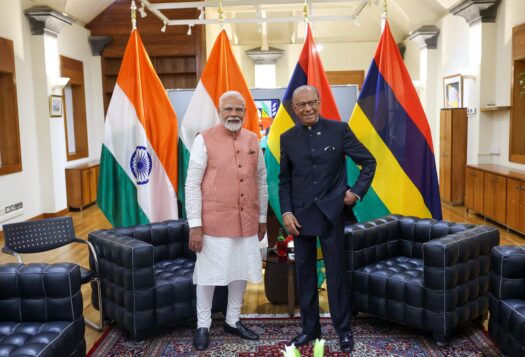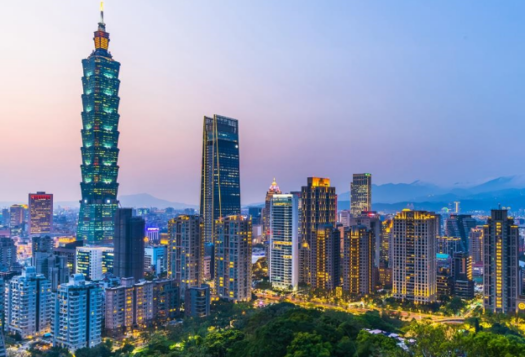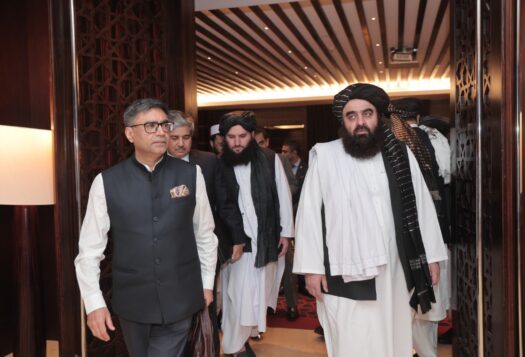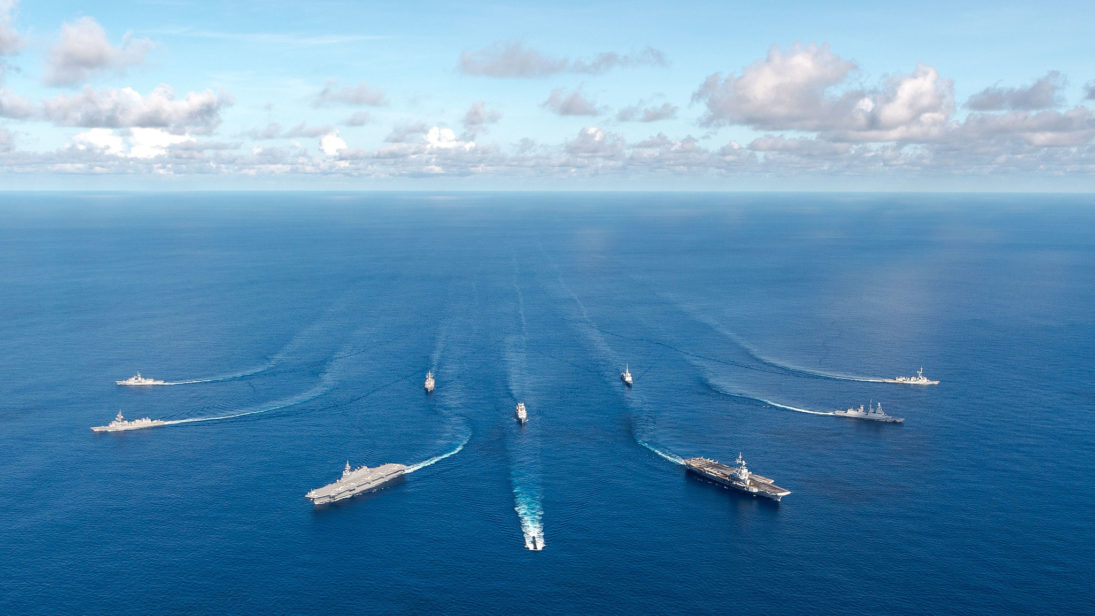
As expected, the United States-China trade war loomed over this year’s Shangri La Dialogue, held between May 31 and June 2 in Singapore. Without identifying China by name, the United States cautioned against certain actors that employ a “toolkit of coercion” in the Indo-Pacific comprising advanced weapons systems deployments to militarize disputed areas, interference in other countries’ domestic politics, engaging in predatory economics, and promoting state-sponsored theft of other nations’ military and civilian technology. Though the reference was implicit, the finger pointing towards China could not have been more obvious.
General Wei’s speech presented a counter to the American worldview, especially with its vision of an alternative regional order in the form of an Asia-Pacific community with a shared future.
On the other hand, China justified its right to build islands in the South China Sea (SCS), calling the act “self-defense,” and hailed the Belt and Road Initiative (BRI) as a success. Although much of his justification for the militarization of the SCS is contestable, in making strong statements against the United States’ stand on Taiwan and the SCS and through the proposal to build an Asia-Pacific community, General Wei Fenghe’s speech presented the Chinese vision for an alternate order. His assertion regarding the ongoing trade war with the United States—that China will not be bullied and is ready to fight “till the end”—shows Beijing’s hardening position that could pose strategic hurdles for trade, security, and stability in the Indo-Pacific region.
This leaves the Indo-Pacific region at the crossroads of two opposing approaches to regional security. General Wei’s speech presented a counter to the American worldview, especially with its vision of an alternative regional order in the form of an Asia-Pacific community with a shared future (which ostensibly excludes the United States) and with no mention of the term “Indo-Pacific.” Here are a few takeaways from the Dialogue for the region.
U.S.Reassurance of Security
In light of threats to alliance partners, the North Korean challenge, the ongoing trade war with China, and an inward-looking United States under Trump, Washington’s security commitment to the Indo-Pacific region has been taken by regional players with a pinch of salt. In this connection, the emphasis in Acting Secretary of Defense of the United States Patrick Shanahan’s speech on building preparedness and partnerships as well as promoting a networked region and announcing enhanced financial commitments and substantially increased U.S. defense spending in its “priority theater” would have assured U.S. partners and allies in some measure.
Towards boosting regional trust in the Indo-Pacific, one of the most reassuring developments underscored in Shanahan’s speech was the modernization focus of the U.S. Department of Defense over the next five years involving technologies like undersea warfare, tactical aircraft, C4ISR, missile defense, and areas like cyber and space. Importantly, Secretary Shanahan drew distinction between past and present U.S. commitments to the Indo-Pacific region on the grounds that under the Trump administration, Washington has moved to back up policy planning by an increase in spending on research & development. This emphasis sought to quell any doubts in the region about Washington’s commitments in the face of rapidly-enhancing Chinese strength.
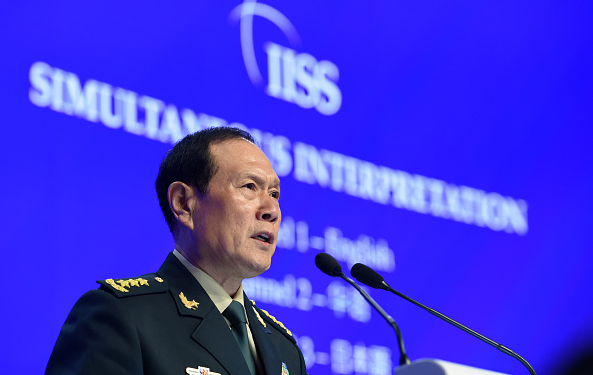
China’s AlternativeDiscourse
While the United States initiated proceedings on day one, day two of the Dialogue began with China’s General Wei Fenghe. It was after an eight year hiatus that China’s defense minister has spoken at the Dialogue, which is significant for two reasons. First, it indicates that China did not want to let go of the opportunity at this important diplomatic forum to counter the Indo-Pacific discourse with its regional security discourse. As China gathers strength, it has realized that capability enhancement and the battle of narratives are two linked yet distinct fronts, both of which have to be conquered. Second, China seeks equal footing with the United States, which was apparent from the hard negotiations it conducted to secure a slot for General Wei at the Dialogue. General Wei’s Shangri La speech is an assertion of this discourse battle, aiming to weave a counter narrative for the countries of the Indo-Pacific about what China offers, in a challenge to the United States. To that end, China’s latest BRI forum comprising 6,000 delegates from 150 countries and 92 international organizations was also cited.
Australia,France, & the Indian Ocean
Another important trend emerging from this year’s Dialogue is the deepening commitment of Australia and France in the Indian Ocean and the larger Indo-Pacific. Both countries have stepped up their activities in the region, as laid out by their defense ministers. Florence Parly, the Minister of the Armed Forces of France, cited the example of a French carrier battle group that was recently deployed in the Indian Ocean. Last month, Australia solidified its engagement with the region by docking frigate HMAS Toowoomba of the Royal Australian Navy at India’s Chennai port for a week.
Another important trend emerging from this year’s Dialogue is the deepening commitment of Australia and France in the Indian Ocean and the larger Indo-Pacific. … India should club its engagements with Australia and France to together capitalize on opportunities in the Indo-Pacific as well as deal with the growing challenges in the region.
Interestingly, both identified India as their partner of choice in this endeavor. Parly reiterated President Macron’s idea of “an Indo-Pacific axis with France, India and Australia as its backbone,” contributing to regional stability through military and security cooperation. Linda Reynolds, Minister of Defence for Australia also underlined an important role for India in shaping Indo-Pacific security along with other powers. Linking the importance of Australia and India’s bi-annual AUSINDEX exercise to the Indo-Pacific endeavor, Reynolds also gave credence to the merit of a France-India-Australia trilateral and underscored the centrality of the Indian Ocean to all three countries. Taking cue from these pronouncements, India should club its engagements with Australia and France to together capitalize on opportunities in the Indo-Pacific as well as deal with the growing challenges in the region.
Though the recent meeting among the Quad countries shows the new Indian government’s strong intent to continue to prioritize the Indo-Pacific and maintain a rules-based global order, India’s absence at Shangri La this year was questioned by a few delegates, especially since Prime Minister Narendra Modi was the keynote speaker last year. The lack of high-level representation from India, albeit due to the new Indian cabinet being announced a day prior to the Dialogue, was somewhat of a missed opportunity for New Delhi to reiterate its commitment to the region along with its Indo-Pacific strategic partners such as the United States, France, Australia, and Japan.
As for the broader Indo-Pacific region, this year’s Dialogue failed to assuage the concerns of smaller countries caught in the crossfire of competition between the great powers of the region. Amidst this dilemma for small states regarding who to side with, the Indian Ocean is likely to emerge as a battleground, especially as China hardens its stance vis-à-vis the South China Sea and further consolidates the BRI.
***
Image 1: U.S. Indo-Pacific Command via Flickr
Image 2: Roslan Rahman via Getty
